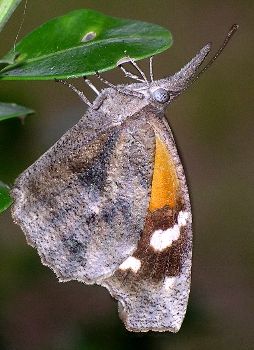by Valerie
February, 2005Snout Butterfly
While not as striking and colorful as some of our larger butterflies, the snout butterfly (Libytheana bachmanii) is easily identified. The long protrusion on the front of the head is actually a pair of labial palpi, the structures which protect the proboscis when it is curled up. Snout butterflies often rest on branches and resemble dead leaves, and it is speculated that the snout adds to the illusion of a leaf stalk. The individual pictured here is a female; the first pair of legs on males are very tiny and are held up close to the body. The larvae feed on hackberry trees, which are in plentiful supply around our area. The adult butterflies are under two inches long. Most of the time, I find this species only occasionally. However, these butterflies are known for their sporadic, but spectacular mass migrations. I first saw this several years ago when I was commuting to a temporary job in San Antonio. As I was driving back and forth from Austin on I-35, I kept noticing what looked like thousands of small brown leaves blowing in the wind. The strange thing was that they came in dense groups even when there were no trees around, and when some got close enough, I could tell they were butterflies. It was inevitable that one or two of the insects would end up on my car's front grill, so I quickly identified the species. The reason for the infrequent migrations is probably environmental. If food supplies are good, the population explodes, then the emerging adult insects must disperse. |
(More information on snout butterflies is available in "larvalbug's garden.")